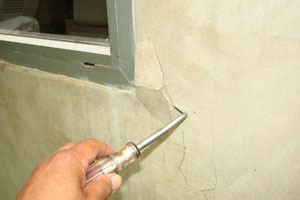LHC Newsletter Vol. 4, No. 2
“CONDOMINIUM BUYERS BEWARE: FAILURE TO REQUEST DISCLOSURES ABOUT THE DEVELOPER AND BUILDER MAY COST YOU DEARLY”
By: Robert D. Hillshafer, Esq.
Fact: A substantial percentage of condominium developments have significant construction defects and end up in litigation over these defects.
Fact: Municipalities and their Departments of Building and Safety are not responsible for preventing construction defects and are immune from civil liability for negligent construction, even if the construction was inspected and approved.
Fact: Developers and Contractors are not legally obligated to carry liability insurance for defective construction and because of the high cost and potential insulation from liability; many do not carry any liability insurance
Fact: Developers/Sellers of new construction condominiums are not legally obligated to disclose whether they or the contractors hired to build the project carried appropriate liability insurance.
Fact: Principals of Developers and Contractors are not necessarily liable for damages related to construction defects caused by negligent construction. After projects are sold out, the selling entities generally are maintained as asset-less shells to insulate the principals who have reaped the profits from the sales. This is more frequently found in smaller “in-fill” projects within older neighborhoods.
Fact: The lack of appropriate liability insurance for the Developer, General Contractor and Subcontractors will severely impact the value and saleability of a condominium in a project that has construction defects.
Fact: Real estate salespersons/brokers are generally not liable for defects in construction unless they had actual knowledge of them and failed to disclose them.
Most buyers of condominiums, particularly in new projects, are not aware of these facts and consequently do not consider them in the context of a purchase of a condominium. However, they certainly should consider these facts and attempt to obtain answers prior to purchasing a condominium. While certainly not secrets, most condominium owners learn these facts the hard way; after their association determines that serious defects exist that will cost hundreds of thousands or millions of dollars to repair. Most owners in this situation are surprised that there are not more built-in safeguards to protect them.
As a lawyer who has handled construction defect litigation for and against associations for over twenty years, I am seeing more and more condominium developers and contractors go without insurance, making it very difficult to successfully resolve legitimate construction defect claims/litigation to allow association’s to repair construction defects. In addition, because of the rules governing civil litigation, there is no way of knowing whether the developer or contractors on a particular project carried liability insurance for construction defects until after the construction defect lawsuit has been filed.
Although the focus of this article is condominiums, the same facts and considerations apply to a purchase of a detached single family home, although generally to a lesser extent because SFH developers are generally larger, more financially viable entities and because the Association does not “own” the collective claim for construction defects as in a multi-family project. Obviously, if a well known, long standing builder is the developer of SFH’s, the risk of having an uninsured, judgment proof entity be responsible for construction defects is greatly reduced. Also, the construction of multi-family buildings is far more complicated from a design, engineering and construction standpoint such that a prospective purchaser’s ability to obtain an affordable inspection of all the important common area systems in a multi- family project by a competent expert is simply not likely to occur.
What can you do to protect yourself?
- Request the Seller/Developer to disclose whether it and the general contractor and subcontractors who built the project carry liability insurance which covers claims for defective construction of condominium projects.
- Request a copy of the Declarations page of the Developer’s and General Contractor’s liability insurance policy. (Note: if the Developer and GC have insurance, there is a strong probability that the subcontractors will also have insurance because the Developer and GC will demand it.)
- Request a list of all the contractors and material suppliers on the project so that you can perform due diligence on these companies with the Contractor’s State License Board and perhaps check for pending legal actions against them. Notable subcontractors are waterproofing, roofer, stucco, window, sheet metal, plumbing, electrical, and framer.
- Request a copy of the final certificate of occupancy issued by the applicable municipality. (Believe it or not, I have one project where a temporary C of O expired but the developer never obtained a final but went ahead and sold units anyhow, in violation of City statute. The City did nothing to stop the sales.)
- Request a disclosure concerning any water intrusion problems which have been experienced since the project was completed and how the problem was resolved.
- Carefully review the proposed sales contract and Declaration of CCR’s concerning dispute resolution procedures and notification provisions. The current trend in sales contracts and CCR’s is to limit the ability of buyers and Associations to file a lawsuit, instead requiring arbitration or reference to a private judge for resolution. While not “deal breakers” these provisions are intended to make it more difficult for buyers and Associations to pursue claims. Many contracts also contain onerous reporting provisions in order to assert a claim or designate “warranty” administrators.
- Determine if the Developer/Seller is a “single purpose entity,” which is a limited liability company that is set up only as the vehicle to develop and sell the project. If it is, the liability insurance response is even more critical.
Unfortunately, you will find that these requests will not be well- received by many sellers or their agents. On the surface they will act insulted and insinuate that your intent is to cause problems because these disclosures are not routinely requested or demanded. However, if the Developer/Seller refuses to provide you with the information requested, it should be cause for concern as to whether you should agree to complete the purchase, or complete it for the price sought by the seller. A logical interpretation of the refusal to provide this information is that the Developer or the contractors either do not have the appropriate insurance coverage for negligent construction or that the Developer does not want to sell to a prospective purchaser savvy enough to request these disclosures and information. That should raise a red flag.
How Lack of Insurance or Financial Viability Affects Unit Values
The current and future value of the condominium unit will be indirectly linked to whether the Developer and Contractors have appropriate liability insurance and or other financial resources in the event construction defects are determined to exist. For example, if you have two relatively similar condo projects located in the same vicinity and the units are priced almost identically, but the developer/general contractor of one of the projects is insured and the other is not, I suggest that the project with the insured parties is more valuable and less of a risk to purchase. Similarly, if one of the projects was built by a financially stable company with a long track record and the other by a single purpose entity about which you have no information, it seems logical that the evaluation of value and potential risk would be different between the two.
If you purchase a unit in a development that ends up in litigation, which is often a “last resort” and there is inadequate or no insurance to potentially resolve the lawsuit, unit owners necessarily suffer a loss of value to a unit as follows:
- The Association’s alleging construction defects and seeking damages either in litigation or as part of pre-litigation requirement by statute creates a public record that will devalue the property until the alleged defects are corrected. Until the defects are corrected, the unit will be more difficult to sell and more difficult to re-finance than other properties not involved in litigation.
- The lack of insurance to resolve the case will probably mean that the members of the Association will have to be assessed to make up the shortfall or pay for the repairs in total. These assessments can be in the tens of thousands of dollars per unit. The Association’s insurance does not cover construction defect repairs or damage.
- The lack of insurance may mean that damage to the unit interior cannot be paid for from settlement monies and that the unit owners must pay for the repairs individually.
Forewarned is Forearmed
Although somewhat a cliché, the heading above in the context of a condominium purchase is very apt in this context. When one considers that buying a home generally represents the largest financial transaction of your life, it only makes sense to perform reasonable due diligence concerning the financial wherewithal of the seller to make good on the basic premise that the home you bought is of good quality. Just as a consumer would not be likely to purchase a brand new automobile “as-is” from a company that you believed has nothing to back up its product warranty (unless substantially discounted in price), that should be even more true with a home costing many multiples of the price of a car. The emotional allure of a brand new project should not cause the suspension of due diligence, yet it often does.
Even when purchasing a condominium in a resale context, it is important for a prospective purchaser to ask insightful questions of the seller and the Association and not merely rely upon the bare facts set forth in the Transfer Disclosure Statement and Condominium Certification. Direct and specific questions should be asked of both entities regarding water intrusion problems or other construction defect issues. Contrary to popular belief, an Association is not legally obligated to affirmatively disclose such issues to a prospective purchaser unless it is actually pursuing a claim. However, the disclosure obligation is created when direct inquiries are made to the Association.
There is no way to completely avoid risk when purchasing in a multi-family project, since these communities have very unique dynamics created by the variety of individuals who live within them. However, being aware of the risks created by the facts outlined above and making an effort to obtain answers that would reduce the potential risks prior to purchase could prevent unnecessarily being subjected to the impact of construction defect litigation and uninsured developers and contractors.
©2010 by Loewenthal, Hillshafer & Carter, LLP. All rights reserved. Permission is granted to reproduce or transmit in any form any part of this newsletter as long as proper attribution to Loewenthal, Hillshafer & Carter, LLP is given. Due to the rapidly changing nature of the law, information contained in this publication may become outdated. As a result, lawyers and all others using this material must research original sources of authority.


